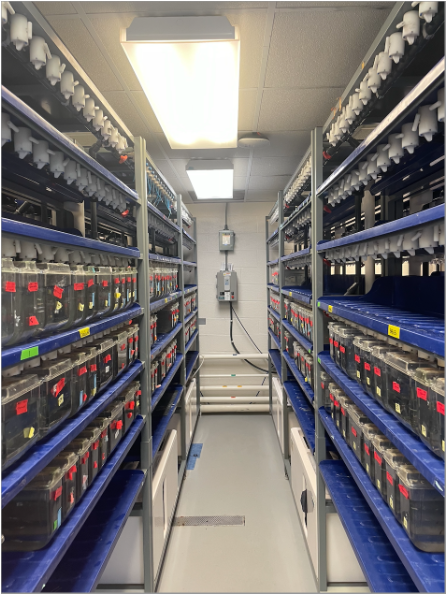The Gene Editor for Hire
Will Atkinson | July 15th, 2023
Imagine a world in which you can walk up to a vending machine, select hair and eye color, height, and blood type, swipe a credit card, and output a baby! Well, to the chagrin of science fiction writers and fear mongers, maybe this isn’t quite possible. The biological science community is, however, making remarkable strides. Brought to you by CRISPR-Cas-9 technology, a future in which gene editing technology can be harnessed to better the lives of millions around the world is becoming a reality.
In 2012, a groundbreaking press release out of a University of California, Berkeley laboratory announced that a naturally occurring protein known as Cas-9 was capable of being repurposed to allow scientists to selectively alter the function of certain genes. In order to understand CRISPR-Cas-9 gene editing (CRISPR stands for Clustered Regularly Interspaced Short Palindromic Repeats), one must first understand where it came from. The scientists that designed the technology co-opted a process that the human body innately performs as a method to fight against viruses. After foreign invasion, each cell stores a bite-sized memory of the virus, so that it can easily recognize it in the future. These “memories” are in the form of CRISPR arrays, which are short RNA sequences that can bind to foreign viruses, allowing the cell to quickly defend itself. In order to apply it to gene editing, biologists used this concept of the CRISPR RNA strands’ capability of recognizing genetic material and coupled it with an enzyme known as Cas-9, which cleaves the DNA, thus selectively knocking out desired genes.
Senior Lecturer by occupation but “gene editor for hire” in spirit, Dr. Clements leads the CRISPR-Cas-9 charge at Vanderbilt University. Dr. Thomas Clements got his start in the momentous year of 2012 working on CRISPR-Cas-9 technology working in a lab at Rice University – as part of his Ph.D. program in Biochemistry and Cellular Biology. At this seminal time, Dr. Clements and his peers utilized their knowledge of the genome to produce short guide RNA sequences – the analog to the CRISPR sequences in the viral defense system – that were complementary to specific genes of study. These guide RNA sequences were mixed with Cas-9 enzyme, giving it the dual capability of recognizing and cleaving a specific location on a strand of DNA.
Nowadays, Dr. Clements spends most of his CRISPR-related studies working with zebrafish. With its external fertilization, its short reproductive timeline, and its genome similar to that of a human, the zebrafish became one of the primary animal subjects in CRISPR Cas-9 studies. Sharing the space with the Patton Lab, Dr. Clements’ zebrafish lair is home to “roughly 10,000 zebrafish, some of which have [been with him] since [his days at] Rice [University].” He is able to use this CRISPR Cas-9 technology to select certain traits – such as pigmentation of the fish – and eliminate them within the embryos of unborn zebrafish, producing genetically modified fish. Dr. Clements is also regularly contacted by other researchers in and around Vanderbilt University who have interest in a specific gene with unknown function. Dr. Clements generates an appropriate guide RNA sequence, mixes it with the Cas-9 enzyme, and performs an injection into a zebrafish embryo, allowing him to identify the gene’s function. For example, if the zebrafish is born without a tail, he will know that the gene is responsible for the development of the tail.
The most consequential sphere of CRISPR Cas-9 research is its pertinence to human genetic modification. While the fear of a dystopian future revolving around the class-based access to genetic modification is both unnerving and worthy of contemplation, the introduction of genetic modification to humans has the opportunity to eradicate incurable genetic disorders such as sickle cell anemia and cystic fibrosis, offering an avenue to completely change the lives of millions for the better. Dr. Clements “believe[s] that we are ten to twenty years from being able to knock out specific genetic disorders pre-birth,” whether that be in egg cells, sperm cells, or in utero. “This can be seen as a common procedure, at some point in the future,” Clements posits, suggesting that the potential boon far outweighs the concern.
When considering the ethicality of genetic modification of humans, it is also important to keep in mind that our meta-awareness of our own impact is by no means a novel development. All throughout the course of history, humans have been forced to reconcile the effects of their pursuits, and while a high degree of reflection is integral, we must regulate our tendency to feign an impression of faultlessness of thought. The widespread use of CRISPR Cas-9 on humans is not a question of if, rather, a question of when, so it is paramount that “we figure out the right way to do it.”
Works Cited
Bio | Department of Biological Sciences | Vanderbilt University. [accessed 2023 Mar 19]. https://as.vanderbilt.edu/biological-sciences/bio/thomas-clements/
Cystic Fibrosis – What Is Cystic Fibrosis? | NHLBI, NIH. 2022 Mar 24 [accessed 2023 Mar 19]. https://www.nhlbi.nih.gov/health/cystic-fibrosis
lcyarris. Programmable DNA Scissors Found for Bacterial Immune System – Berkeley Lab. Berkeley Lab News Center. 2012 Jun 28 [accessed 2023 Mar 19]. https://newscenter.lbl.gov/2012/06/28/programmable-dna-scissors/
Sickle Cell Disease – What Is Sickle Cell Disease? | NHLBI, NIH. 2022 Jul 22 [accessed 2023 Mar 19]. https://www.nhlbi.nih.gov/health/sickle-cell-disease
What are genome editing and CRISPR-Cas9?: MedlinePlus Genetics. [accessed 2023 Mar 19]. https://medlineplus.gov/genetics/understanding/genomicresearch/genomeediting

